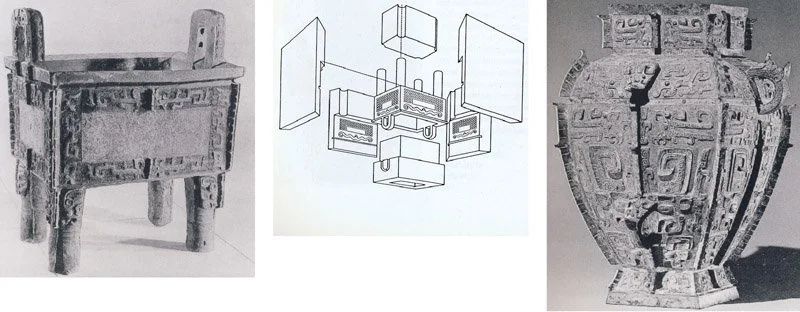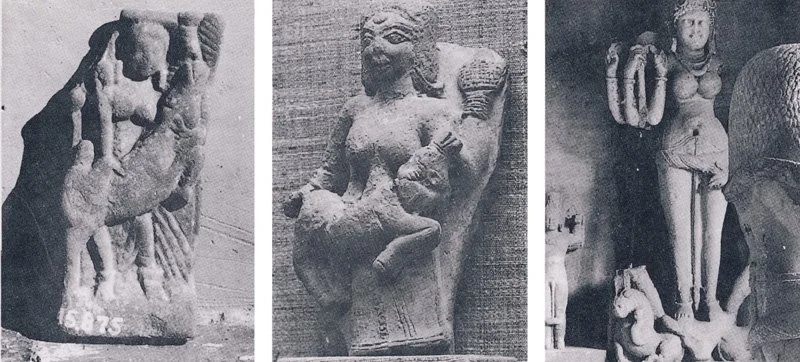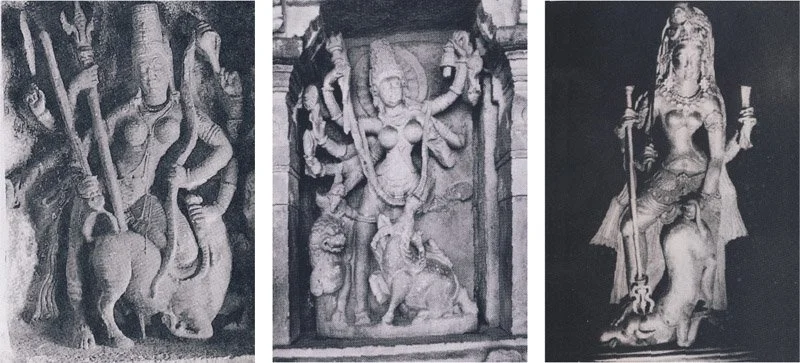Durga Wheel
A performative sculpture exploring the phenomenon of Durga Mahishasura Mardini
Durga was my thesis piece for the Master's of Fine Arts degree at the UCLA department of Design Media Arts. Durga was featured on AIGA’s Design Envy gallery, and MoreStarch.
This installation retells the story of Durga MahisasuraMardini, a Hindu goddess, as animations projected onto a wooden disk. The disk is a projection surface and interface; the viewer navigates the story by turning the disk. Part of the story is painted on the disk, and the rest is revealed through changing projected images. There are two different versions of the story. If you rotate the wheel counterclockwise the wheel tells the story of Durga and Mahisha fighting one another. If you rotate the wheel clockwise, Durga and Mahisha fall in love instead.
This project began as an investigation into the relationship between two symbols: a tiger eating a man - the Tao Tie from China, and a woman killing a buffalo - Durga Mahisasura Mardini from India. To me studying the history and context of these two images provides a glimpse into the ways that politics, power, technology, and pattern are all intertwined, and how the smallest gesture of craft actually resonates throughout this sometimes invisible web. The Tao-Tie symbol was a point of comparison while considering the main subject of my story: Durga Mahishasura Mardini. As she appears in India over the centuries, Durga is an icon, a comic, a political tool, a religious festival, and more. While considering the evolution of both phenomena, I kept returning to the question of how they relate to the mechanisms of production and political power. Looking back at my research, I think subconsciously I was reaching towards the universal language of pattern and craft to gain an understanding of Indian and Asian culture, which looms in my life as something massive, opaque, unfathomable, distant but somehow embedded in my identity.
The Image on the left: a bronze container from the Shang Dynasty, originally published in Art, Myth, and Ritual: the Path to Political Authority in Ancient China. by KC Chang, Cambridge, Mass.: Harvard University Press, 1983. p. 62. The image on the right is a sculpture of Durga Mahishasura Mardini from a temple in Orissa from the 10th century CE, originally published inThe divine and demoniac: Mahisa’s heroic struggle with Durga by Carmel Berkson. Delhi: Oxford University Press, 1995. Plate #24
The image on the left is a bronze container from the Shang dynasty. This container, among others from this time, have become famous for their insight into the spiritual practices of ancient China. Seeing a number of Shang bronze vessels at the Met more than 10 years ago I was first struck by the universe of order and design contained in the intricate patterns. They speak a visual language that seems to span culture and time. This inspired a bit of research and a couple art history classes at UC Berkeley, which became one of my majors. I came across a small book called Art, Myth and Ritual by Harvard professor KC Chang about these objects. Chang argues that this symbol is evidence of the way that Shang shaman saw animals as a portal to heaven and political authority through sacrifice. He writes:
“These documentary data, recalling the passage in Kuo-yu, have enabled us to understand that the sacrificial animals were the same ones which had the power to help the shamans and the shamanesses in their communication task, and to make animal offerings was a concrete means of achieving communication between Heaven and Earth, the dead and the living.”
The evolution of the Tao Tie Symbol, traced from Chinese pottery ranging from 18th to 12th century BCE. Images from Art, Myth, and Ritual: the Path to Political Authority in Ancient China by KC Chang, Cambridge, Mass.: Harvard University Press, 1983. p. 62.
The images above show how there is a close relationship between the development of visual language and the methods of production of clay and bronze pottery. For instance the use of multiple panels to cast the faces of the ritual vessels encourages a modular approach to pattern. Lothar Ledderose summarizes some of these ideas in his book 10,000 Things: Module and Mass Production in Ancient China, which discusses some amazing examples of how a modular approach to design influences language and visual culture in China:
“Growth in manufactured modular units happens in two ways. For a while, all modules grow proportionally, but at a certain point proportional growth stops and new modules are added instead… This is the principle of a cell growing to a certain size and then splitting into two, or of a tree pushing out a a second branch instead of doubling the diameter of the first. “ (Page 6 from 10,000 Things, Lothar Ledderose)
Large ritual vessels called Ding from the 12th Century BCE in China. The center image shows the casting process of these vessels, which uses modular molds to produce surface patterns in relief. Originally published in Ten Thousand Things, Module and Mass Production in Chinese Art by Lothar Ledderose, Princeton, NJ, Princeton University Press, 2000. pg. 27, 38, 37.
Sculptures of Mahishasura Mardini across India ranging from 1st - 5th Century CE. Images from The Divine and Demonaic by Carmel Berkson. Oxford University Press, 1995. plates #16, 17, and 20.
The Divine and Demonaic plate #21, Images on the right from The Art of Ancient India by Susan and John C. Huntington, New York, Weatherhill 1985. page 375.
Sculptures of Mahishasura Mardini across India ranging from 10th- 11th Century CE. Images fromThe Divine and Demonaic by Carmel Berkson.Oxford University Press, 1995. plates #27, 26, and 24
Moving to the image of Durga in India, one can observe a similarly fascinating trajectory through centuries of sculpture, painting, performance and other media. The sculptor Carmel Berkson, among others, believes that the symbol of a woman killing a buffalo in India started as a sort of apotropaic or talismanic sculpture, not unlike a gorgon's head on a shield. Berkson and Joseph Campbell both write about animal sacrifice as a means of warding off misfortune in ancient India. According to both Berkson and Campbell artists made images of sacrifice perhaps to evoke some of the same good luck magic.
Over time, this symbol naturally evolved into many different kinds of Devi or mother goddess narratives. Before the 6th century CE, a lot of these stories were communicated and memorized orally, encouraging multiplicity/multivalence. I think this is a common theme in mythologies around the world, like the Odyssey or the Bible. As Brahminical Hinduism and Sanskrit spread, there was a push to commit these ideas to paper and integrate them into the mainstream narrative. Brahmins also imposed written law in an effort to consolidate power, which included sanctions against animal sacrifice. This obviously affected animal sacrifice rituals! Because of this organic growth, the characters and story of Durga take many forms. As a folktale, Durga evolved into performances and annual festivals that take different shapes across India. For instance the Durga Puja in Orissa is an internationally known festival involving life-size sculptures of the two characters traveling between different shrines.
Images of Durga originally published in The Devimahatmya paintings preserved at the National Archives, Kathmandu.Tokyo: Centre for East Asian Cultural Studies for Unesco, 1995. pages 80-82
“Durga- the Slayer of Mahisha” Originally published in Tales of Durga. Amar Chithra Katha Comics. no.176. India Book House Pvt. Ltd., 1978., page 15
Above you can see some attempts to represent the myth of Durga Mahishasura Mardini ranging from the 7th-20th cenury. In the hand-painted sequence from Nepal she functions simultaneously as a character in a story and as a physical manifestation of the divine. You can see these artists experimenting with the representation of time, for instance where the lasso used to trap Mahisha the bull hangs in two places at once. There are also versions of this story where Mahisha is the hero, as shown by a sculpture in Mysore where Mahisha is actually worshipped as a hero. Of course the idea of Durga is also captured in temple architecture which introduces a unique spatial interpretation of the story in the form of circumambulatory prayer.
On the left is a relief of Mahisha fighting Durga from the 7th century CE at Mamallapuram in Tamil Nadu, and on the right a sculpture of Mahisha at Chamundi Hill in Mysore, Karnataka. The image on the left was originally published inThe Art of Ancient India by Susan and John C. Huntington, New York, Weatherhill 1985. page 302. The image on the right was originally published in The Divine and Demonaic: Mahisha's Heroic Struggle With Durga, by Carmel Berkson. Delhi: Oxford University Press, 1995. plate #9.
On the left: the cover of the Vishva Hindu Parishad’s “Sacrifice for Unity” souvenir volume.1983. Originally published in Hawley, John Stratton, and Donna Marie Wulff. “Bharat Mata.” DeviÌ„: goddesses of India. Berkeley: University of California Press, 1996. 255-257. Print. pg. 256. On the right: Mother India (detail) Abanindranath Tagore, 1905.
Up until this point in my research, I had been creating a series of drawings which you can see here. But considering this phenomenon as an architecture for storytelling, I realized that a conventional graphic re-telling doesn't really address the variety of narrative forms used to tell stories about Durga. So I started to experiment with different media. Above you can see a prototype laying out the story on a wheel, thinking about how it might be told with a new device.
In my mind, this device addresses the unique (but in some ways universal) aspects of the phenomenon of Durga. Durga is performed annually as a festival, so it is cyclical. In paintings she is an apotropaic (talismanic/protective) representation of god, so she's also abstract and static. As I mentioned above there are multiple conflicting versions of Durga's story In film, comics, and poems. I hope this new device speaks to all of these aspects of Durga, showing a branching narrative that can be performed. And when it's still I hope the static, glowing frame reminds the viewer of the optical nature of animation or the "Machinis Versitalis" as Norman Klein writes in his book 7 Minutes.
Left to right: Willem de Kooning, Woman 1, 1950-52, oil on canvas, Willem de Kooning, Rosy-Fingered Dawn at Louse Point, 1963, oil on canvas, Piet Mondrian. Composition No.10 (Pier and Ocean). Oil on canvas. 85 x 108 cm. 1915.
I believe there is a relationship between representating the figure in Indian art and the abstract expressionism in 1950s America. Because of the multiplicity of the narrative of Durga, artists could not look to naturalism to represent her character. Not unlike painters Piet Mondrian or Willem DeKooning. I think there are some parallels between the use of Durga as a political tool by the Hindu National Party, and the concept of "hot" and "cold" media discussed by Jean Baudrillard and Marshal McLuhan. McLuhan writes:
"There is a basic principle that distinguishes a hot medium like radio from a cool one like the telephone, or a hot medium like the movie from a cool one like TV. A hot medium is one that extends one single sense in "high definition.' High definition is the state of being well-filled with data. . . . Hot media are low in participation, and cool media are high in participation or completion by the audience. . . . "
McLuhan might be a little obtuse, but I think he's suggesting that cool media like television precipitated the cold war through paranoia and speculation on the part of the audience. So the way an artist like Abanindranath Tagore wields an image like Durga can be "cool" in the way that it addresses nationalism through representation.
I reached a conclusion about these two phenomena as they travel into the present day. Both of these cultures - Indian and Chinese- developed a complex visual and performative language surrounding a ritual that situates artists, priests, and political figures in relation to the divine. In India, I would liken the prayer verse and mantra to the bronze vessel in China, because these structures provide an architecture for the evolution of the phenomena of Durga. Teasing out the shape of these boundaries and the trajectory of a symbol like Durga gives us a glimpse into how the stories we tell are intertwined with the way we move and communicate, and why we must continue to analyze these stories in order to understand who we are now.











